October
Observations
October 22
and 31
I approached Cottonwood
Pond from my usual angle on October 22, which is from the top of the
woods, down the slope, west of the area.
But my approach on October
31 was through the woods from the northwest, toward the side of the
area.
The fallen Cottonwood Trunk from a distance
As I descended the slope
on the 22nd, I heard a rustling in the distance. I looked
up to the far upper side of the woods ...
… and spotted deer! They
had been passing through, but then detected my presence (maybe by my
footsteps in the early gathering of dry leaves on the ground), and
stopped, very still, watching me.
As I reached Cottonwood
Pond, I heard the loud whistle-snort that I knew was a warning to me,
as well as an alert to the other deer. I could not see how many there were, as they blended so well into the woods, despite their size.
Some dashed down the slope and off to the west. I could detect some
motion, some flashes of light brown, but otherwise could only hear
their serious rush through the leafy woods.
It seemed as if, surely,
they had all run off to an area less populated by pesky humans. After
being still for awhile, I started moving around Cottonwood Pond,
quietly investigating. After I had observed all around, my plan was
to wander further into the woods for a nice early autumn walk. But,
as I stepped into the Swampy Spot to the east, I heard another loud,
sudden whistle-snort above me. Some were still there! I decided then
that my presence was too disturbing to them that day, and I also
didn't want to bring myself harm from a protective buck. Back up
the front slope I went, up to the house.
On the 31st I
decided to start out with an autumn woods walk, carefully listening
and watching for deer. After all, it was Halloween – a time to be
frightened for no real reason. I would not be, though. So, I quietly,
carefully wandered the woods, eventually coming upon Cottonwood Pond
from the northwest side, through the bottom floodplain area. Coming
upon Cottonwood Pond this way seemed almost like sneaking up on it.
From this direction, I immediately had a view of both sides of
the Root Ball. I thought about how much this view has changed over
the time I have been observing this place.
On that day, there were
some damp places, but no standing water anywhere but the Creek.
Fallen leaves had created a layer of covering on the pond bed and
everywhere else. Other than dips in the ground here and there, it all
looked pretty much alike.
In contrast, there had
been some rain before my October 22 visit, but after a dry period.
Water was settled into a
small bowl of earth before the Root Ball. The increasing size of the
Mud Piles seemed to be squeezing the bowl into a narrower shape.
Leaves had begun to fall, but there was still much space between them
on the ground. And, I thought the Young White Ash at the edge of the
pond was leaning farther than it used to.
The changes over time with
the Root Ball, the Mud Piles, and the surroundings had been visually
aging the general look of the area. Here, I thought, was a funny old,
lumpy woods gnome, with a set of dark, deep-sunken eyes, a bulbous
nose, a crooked smile above the Mud Piles, and a shaggy, stringy mop
of hair hanging partly over its face – a friendly looking face, at
that.
The Bent Blue Beech, which
arched over the southeast end of Cottonwood Pond, had been developing
a serious crack at the highest point of its arch, and on October 22nd
it was much more pronounced.
Though it looked very dead
and dry, it had green, leafy saplings growing from the lower part of
its trunk and its base. Where it continued on the other side of the
Root Ball, there was a trio of connected Blue Beech saplings that had been growing quickly.
Here are more comparisons
from the two October visits:
Viewed from the southeast:
October 22
October 31
Looking down from above the Barkless Log over the Inlet:
October 22
October 31
October 22:
North pond corner, Two-Trunk White Ash, Isthmus, with Root Ball and Mud Pile #1 on the right
Looking southeastward across the pond to the Inlet
"little pond"
The area on the 22nd
was full of fresh crawdad chimneys and raccoon prints in the mud.
But, the bottom of the
main pond on the 31st exhibited a strange phenomenon. The
soil had been churned up into a granular texture.
It was not just below the
fallen leaves, but churned up over the top of some of them.
What had created this? Was
it some sort of small animal activity, burrowing and tossing dirt?
Did it have to do with changes in weather, temperature, and soil
condition? At this point, we had not had any frost. It was an
unseasonably mild month. Or, was it just more dirt fallen from the
Root Ball, then dimpled by rain? We had not had much rain to speak
of.
This was one of the
Mysteries of Cottonwood Pond. Another was the holes that had been
appearing on the Root Ball Bottom ...
… the Root Ball Top …
… as well as the hole
that appeared over the summer in the bottom of “little pond”, not
far from the fallen Trunk. Even during a dry period, it had water
inside.
There was the
ever-changing Cove ...
October 22
October 31
... which had not had any drastic changes throughout the month, possibly due to very little rainfall.
Even with the Mud Piles
piling up higher, I could still find a space to see through.
In the middle of the Cove - some light coming through, and a small view of the other side.
"Eyes" to the other side!!
The tiny white Aster was
still blooming next to the pond on the 22nd.
I have not learned the
Asters, and it seems to me they take a great deal of study to
distinguish, but I wondered if this one was Heath Aster (Aster
pilosus.)
Everything else, though,
was in seed or completely dry in October.
Expanse of Wood
Nettle on the woods bottom, October 22
Wood Nettle on October 22
Wood Nettle on October 31
Jewelweed had lost all
blossoms and seeds by the end of the month.
One tall Jewelweed still existing on Mud Pile #1
Over in the Swampy Spot …
what to my wondering eyes did appear? Were those rosettes of new
Monkeyflower plants? Time will tell.
Otherwise, there were
still the remains of Monkeyflower plants from earlier in the year.
October 22
Temporary Creek #1, which pours into the Swampy Spot:
October 22
October 31
From the Swampy Spot to
the Inlet on October 22:
The ball had been pushed
to the far north end of the Swampy Spot by October 31:
It was a very slow Autumn.
Colors were changing slowly, with some trees losing their leaves
early and others hanging on to green color.
Reflection of
canopy in Cottonwood Pond water, Oct. 22
Canopy over Cottonwood Pond on October 22
Sugar Maple tree, still green, nearby on October 22
Canopy on October 31st,
including the Sugar Maple sapling growing from the top edge of the
Root Ball
Acorn cap from Oak tree and fallen Cottonwood leaf on October 22:
The greater dampness on
the 22nd brought forth more moss.
On the Barkless Log, between the Creek and Inlet
It also brought forth some
interesting fungi:
On the Barkless Log over the Inlet
On the Bent Blue Beech
That included some
magnificent Oyster mushrooms on the fallen Cottonwood Trunk:
If I had been sure at the
time that they were Oyster mushrooms, I would have harvested some for
dinner!
This is a fine example of a dying tree giving new life, still
providing for others.
By the 31st,
the Oysters had faded to a pearly sheen with artistic
wrinkles.
As Life ages, its beauty
changes, but it is always beautiful.
Some fresh fungi were
growing from cracks in the same Trunk.
In this odd year, Autumn
at Cottonwood, and almost everywhere, was taking its time.
Would we have a real frost
before long, and how might that affect Cottonwood Pond?
Asian Bush Honeysuckle in
fruit at Cottonwood Pond. This is an exceedingly invasive plant which
has been marching into my woods from both ends. Next time I visit
Cottonwood Pond, I will do something about these. Stay tuned ...









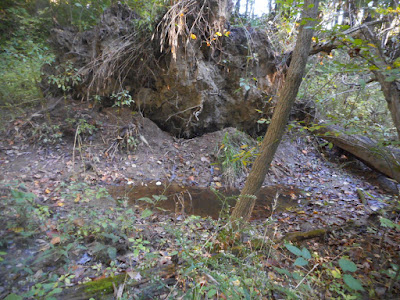






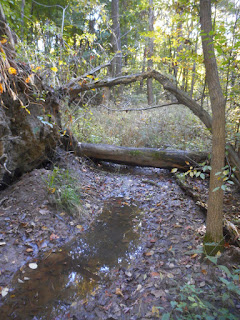




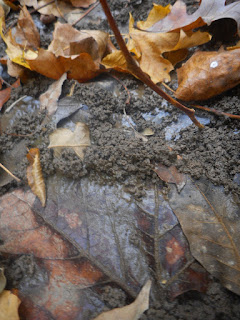

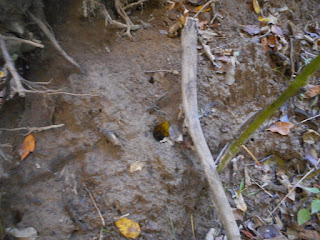


































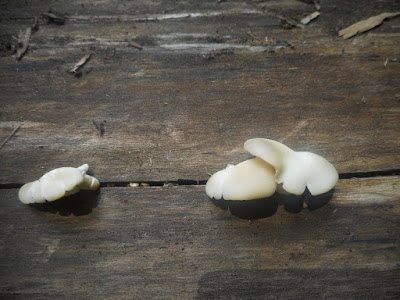

I am surprised to see any water at all there as dry as it has been. Love seeing the mushrooms. It is amazing how those huge creatures (deer) can disappear in the woods or even in a field.
ReplyDelete